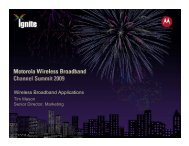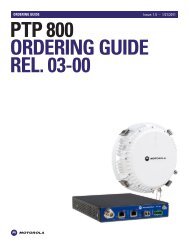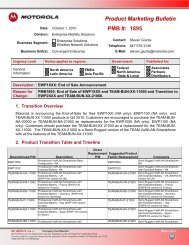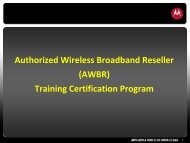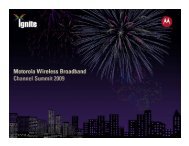Supplement to the Canopy System Release 8 User Guide PMP 400
Supplement to the Canopy System Release 8 User Guide PMP 400
Supplement to the Canopy System Release 8 User Guide PMP 400
You also want an ePaper? Increase the reach of your titles
YUMPU automatically turns print PDFs into web optimized ePapers that Google loves.
<strong>PMP</strong> <strong>400</strong> and PTP 200 Series<strong>Canopy</strong> <strong>User</strong> <strong>Guide</strong> <strong>Supplement</strong>2.3 CONFIGURATION OPTIONS – RF, IP, DFSThese systems use <strong>the</strong> <strong>Canopy</strong> Media Access Controller (MAC) layer. Settings like DownlinkData %, Range, and Control Slots are similar <strong>to</strong> <strong>Canopy</strong> FSK radios. An AP can communicate <strong>to</strong>over 200 SMs, similar <strong>to</strong> a <strong>Canopy</strong> FSK AP.The GUI (Graphical <strong>User</strong> Interface) is almost identical <strong>to</strong> <strong>Canopy</strong>’s, with a few additions <strong>to</strong>support OFDM-specific features.Network features like High Priority using DiffServ, MIR, CIR, NAT, DHCP and VLAN are availablefor <strong>the</strong> <strong>PMP</strong> <strong>400</strong> and PTP 200 Series OFDM radios, and are configured in <strong>the</strong> same way as <strong>the</strong>yare for <strong>the</strong> <strong>PMP</strong> 100 and 200 Series and PTP 100 Series radios.In <strong>the</strong> 5.4 GHz band, DFS (Dynamic Frequency Selection) is provided for regula<strong>to</strong>ry complian<strong>to</strong>peration, and is activated using <strong>the</strong> “Region Code” feature. Two alternate frequencies can beconfigured <strong>to</strong> provide service in <strong>the</strong> unlikely case a module detects radar and triggers DFS, <strong>the</strong>same as standard <strong>Canopy</strong>. “External Antenna Gain” may need <strong>to</strong> be configured consistent withany antennas used, <strong>to</strong> avoid making <strong>the</strong> system overly sensitive <strong>to</strong> radar detection. “Whitening,” atechnique used <strong>to</strong> avoid self-interference on <strong>Canopy</strong> FSK radios is not offered as an option on <strong>the</strong><strong>PMP</strong> <strong>400</strong> and PTP 200 Series radios, as whitening is not a technology applicable <strong>to</strong> an OFDMsignal.2.4 RELEASE MAPPING TO PRODUCTS<strong>Release</strong>s run on <strong>the</strong> various products as follows:• <strong>Release</strong> 9.0 or <strong>Release</strong> 8.2.x runs on <strong>Canopy</strong> FSK radios (<strong>PMP</strong> 100 and 200 andPTP 100 Series radios).• <strong>Release</strong> 8.4.x runs on <strong>PMP</strong> 54<strong>400</strong> and PTP 54200 Series OFDM radios.• “<strong>Release</strong> 8.3” is not planned <strong>to</strong> be used for release numbering.• <strong>Release</strong> 9.3.1 runs on <strong>PMP</strong> 49<strong>400</strong> Series OFDM radios2.5 POWER AND GROUNDINGThe <strong>PMP</strong> <strong>400</strong> and PTP 200 Series radios use a 30 VDC nominal power system, instead of <strong>the</strong> 24VDC nominal power system used previously in standard <strong>Canopy</strong>. A new 30 VDC power supply isavailable for <strong>the</strong> CMMmicro, and a new 30 VDC nominal (specified and labeled as 29.5 VDC)power supply is available for <strong>the</strong> SM.The new 30 VDC power supplies can also be used for standard <strong>Canopy</strong>, and are replacing <strong>the</strong> 24VDC power supplies in <strong>the</strong> <strong>Canopy</strong> product line.The <strong>PMP</strong> <strong>400</strong> and PTP 200 Series radios have slightly higher power use than <strong>Canopy</strong> FSKradios, and <strong>the</strong> higher voltage is needed <strong>to</strong> carry <strong>the</strong> higher wattage on cable runs approaching<strong>the</strong> 100 meter (328 ft) maximum length. CMMmicro 24 VDC power supplies and <strong>the</strong> latest versionof SM 24 VDC power supplies can power <strong>PMP</strong> <strong>400</strong> and PTP 200 Series radios for shorter runs.Earlier versions of SM 24 VDC power supplies, especially <strong>the</strong> earlier heavier transformers,cannot. The best practice is <strong>to</strong> use 30 VDC power supplies with <strong>PMP</strong> <strong>400</strong> and PTP 200 Seriesradios, and avoid potential issues and cable-length-specific engineering.Due <strong>to</strong> <strong>the</strong> full metallic connection <strong>to</strong> <strong>the</strong> <strong>to</strong>wer or support structure through <strong>the</strong> AP’s antenna or aconnec<strong>to</strong>rized BH’s antenna, grounding of <strong>the</strong> AP or BH and a 600SSC surge suppressor within 3ft (1 m) of <strong>the</strong> AP or BH is strongly recommended <strong>to</strong> suppress overvoltages and overcurrents,such as those caused by near-miss lightning. APs and BHs provide a grounding lug for grounding<strong>to</strong> <strong>the</strong> <strong>to</strong>wer or support structure. A pole mount kit is available for <strong>the</strong> 600SSC, and provides agrounding lug that can be used for terminating grounding straps from both <strong>the</strong> 600SSC and <strong>the</strong>AP.Issue 3, January 2009 Page 10 of 45








